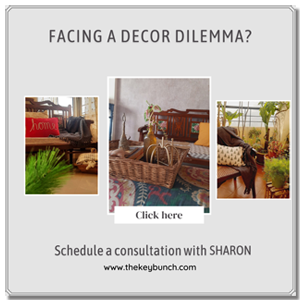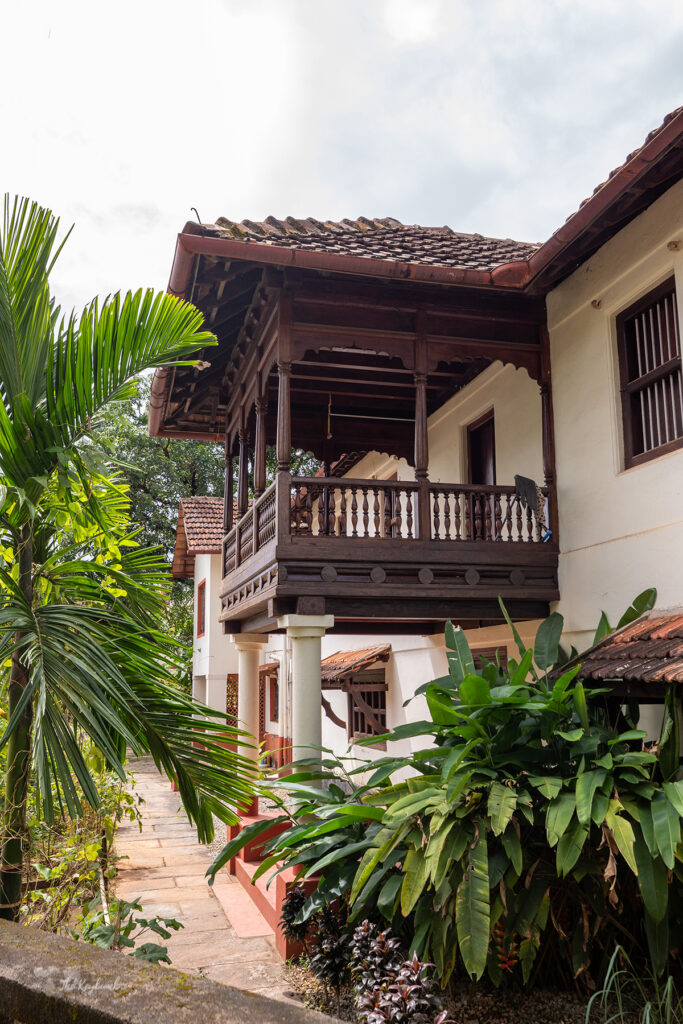
Guthu Mane are the homes of Bunt royalty, of bygone years. They are typically located in the centre of the family’s land holdings, on revered land that is consectrated to a family diety.
An introduction to Guthu Mane
Many of us know about the stately homes of the Chettiars in Tamilnadu, but few outside South Kanara and Udupi districts in Karnataka have heard of the GuthuMane or the Guthu Houses. They were typically owned by the landowners of the region, from the Bunt community, to whom an almost princely respect and reverence was attached. Guthu Mane were built in the centre of the land holdings that each family owned. Before I introduce you to the lovely people who have maintained this inherited property, let me walk you through the features of a typical Guthu house.
Design and Architecture of Guthu homes
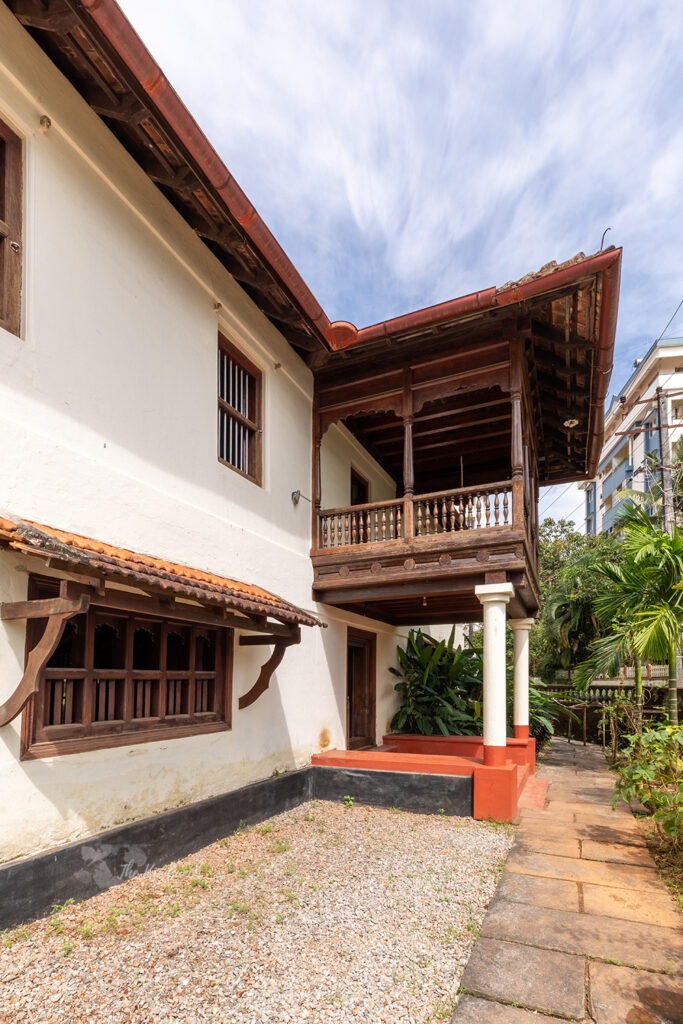
The large houses had a typical design – a thatched front door called the Main Door or the hebbagilu – not really a door but a longish building that served many purposes.
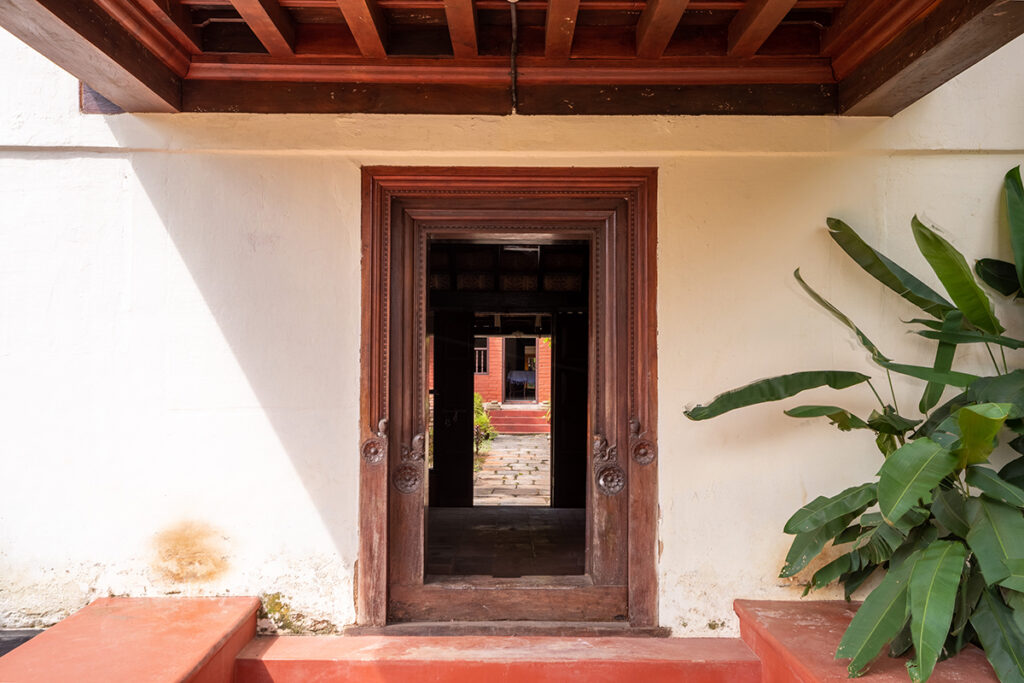
This was where visitors entered the premises. There was drinking water and a small wash area where they could wash the dust off their feet and walk in to the main house through the garden or courtyard. In a parallel building, there were also stalls for bulllocks and cow sheds. There were makeshift quarters for the bullockcart drivers too. Parts of the hebbagilu were used as store rooms to stock the bales of hay, or the produce from the fields.
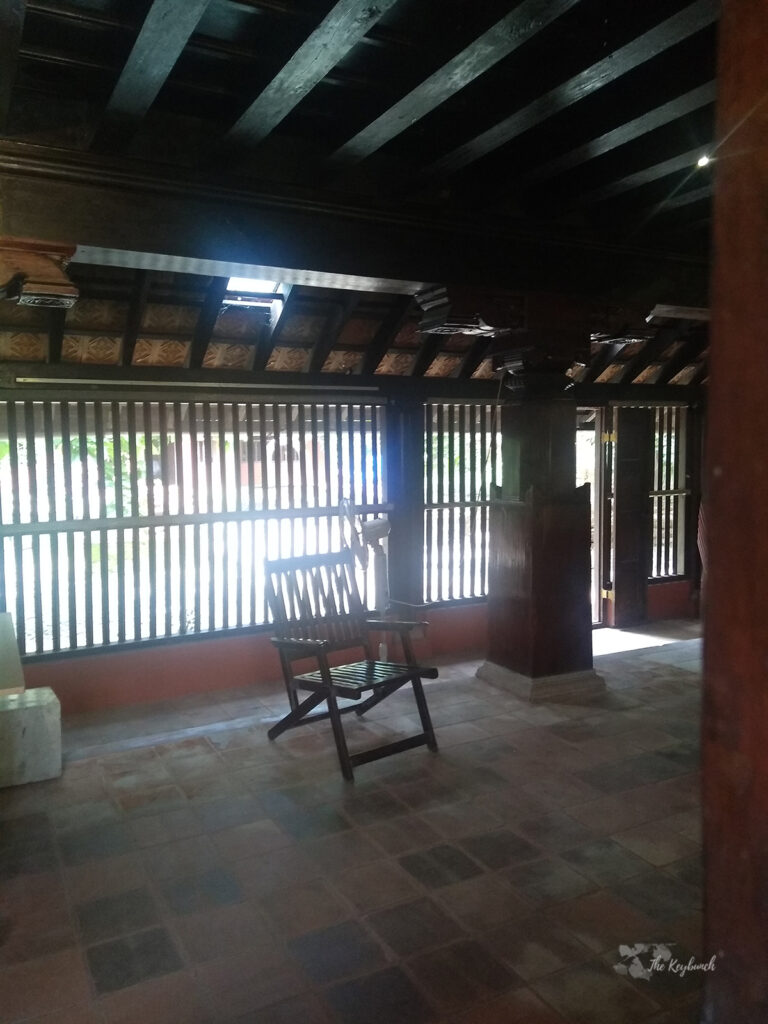
After passing through a courtyard that typically had a garden and a well, one finally reached the main house. All houses had a verandah which was really the hub where the large joint family used to spend time over steaming beverages or food, also where visitors were welcomed and seated.
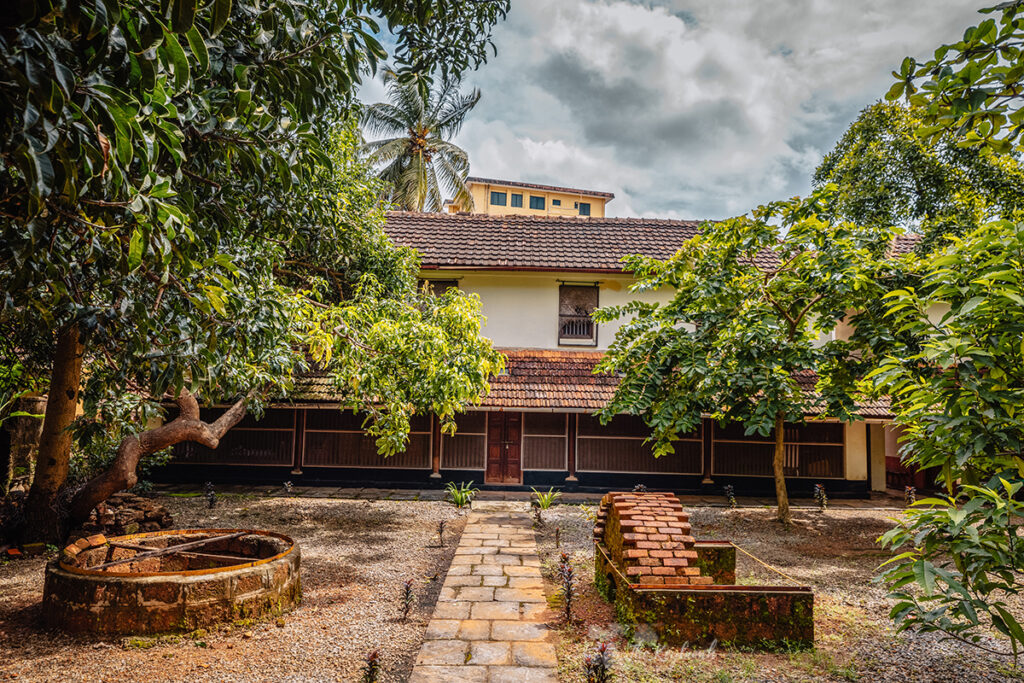
The verandah or jaal is cool and airy. This was where visitors first stepped in. The thatched roof provided a welcome respite from the oppressive heat.
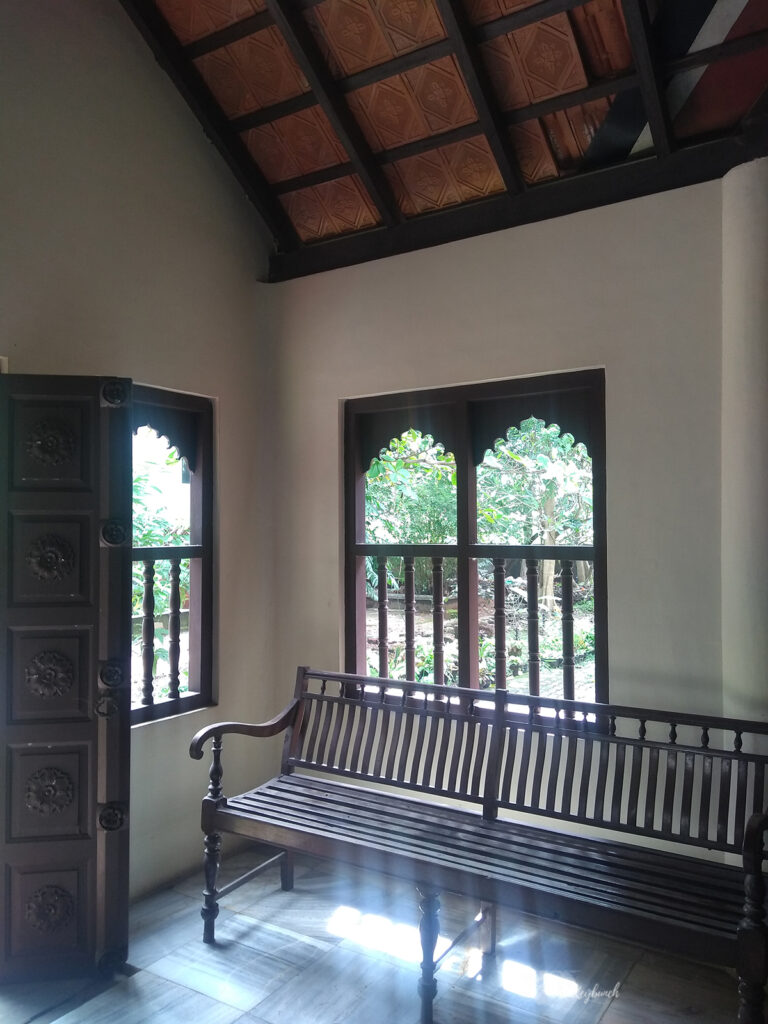
The jaal led into the chavadi – large, exquisitely decorated drawing rooms that sometimes even had a throne. The family heirlooms were also kept and in the more traditional homes the village diety was kept in this room. Bedrooms were typically upstairs or situated alongside a second more private courtyard, leading out from the chavadi
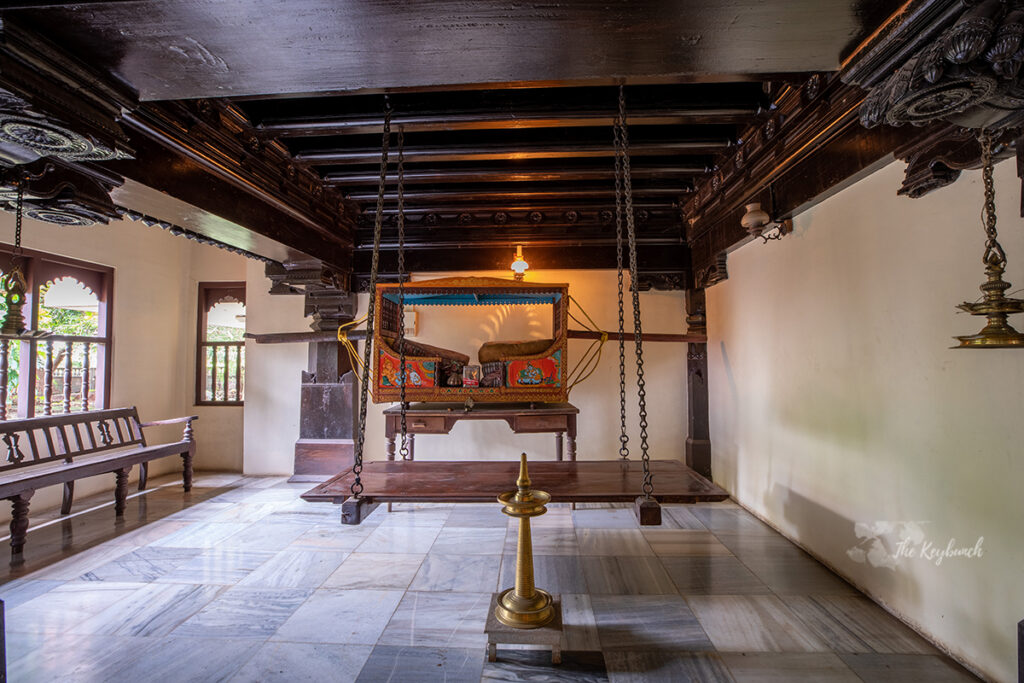
The sloping roofs tiled with Mangalore tiles, and the structure of the buildings was built not only to portray a sense of regality, but also was good design, with a maalige or upper floor level that is so typical of all Mangalore homes. The purpose was to protect the house from the oppressive heat and mugginess, ensure good ventilation.
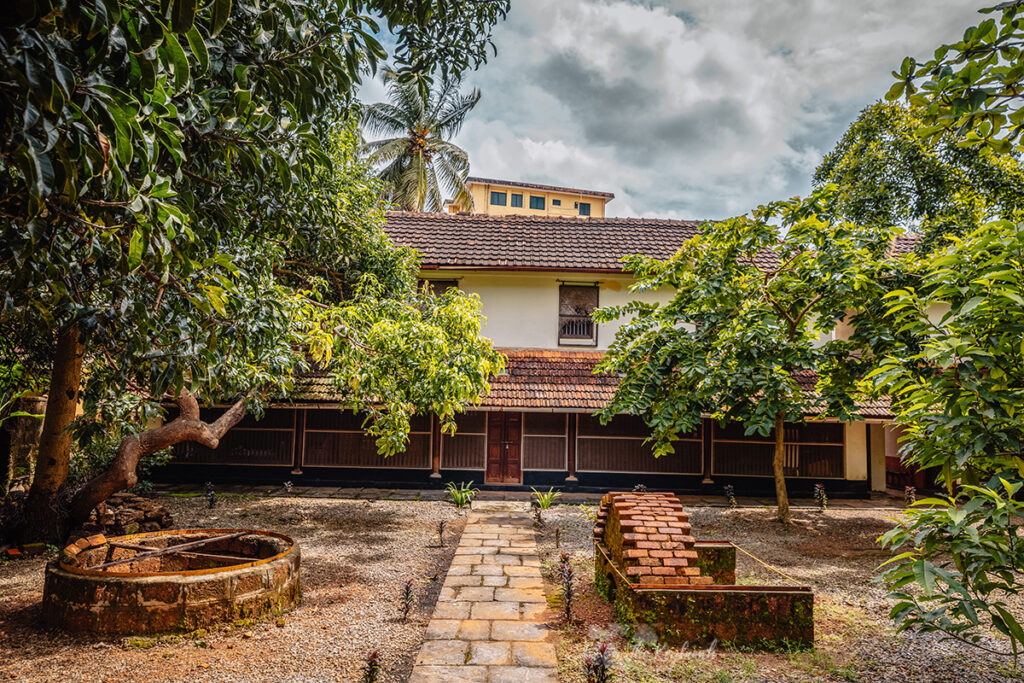
The presence of a lot of woodwork
There is a lot of exquisite wood work in Guthu homes. There are large solid wood pillars, wooden cielings that lend an air of sophisticated elegance to its simple yet expensive features. Teakwood or rosewood was used for the pillars. The beautiful wooden cielings were supported by wooden beams known as jantis.
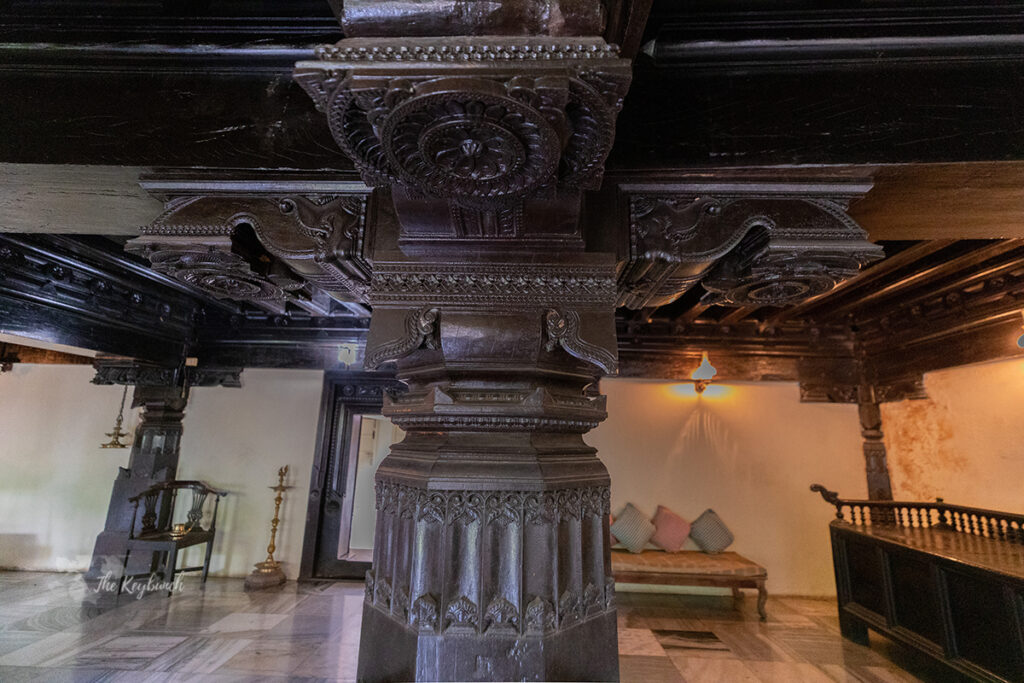
Most Guthu houses have other lovely wooden pieces – for instance, the swing where the head of the house sat, lots of beautiful chests, writing desks, shelves, elegant chairs from the old eras, and not to miss the most loved piece of Mangalore furniture, ubiquitous to homes of all communities – the vakil bench.
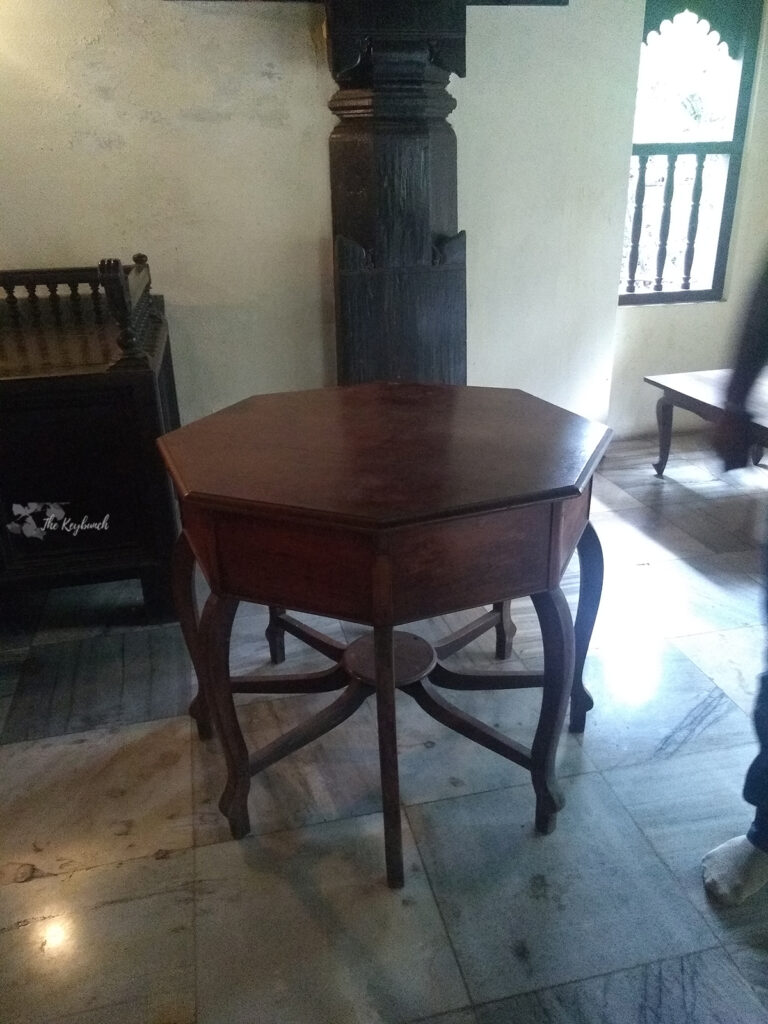
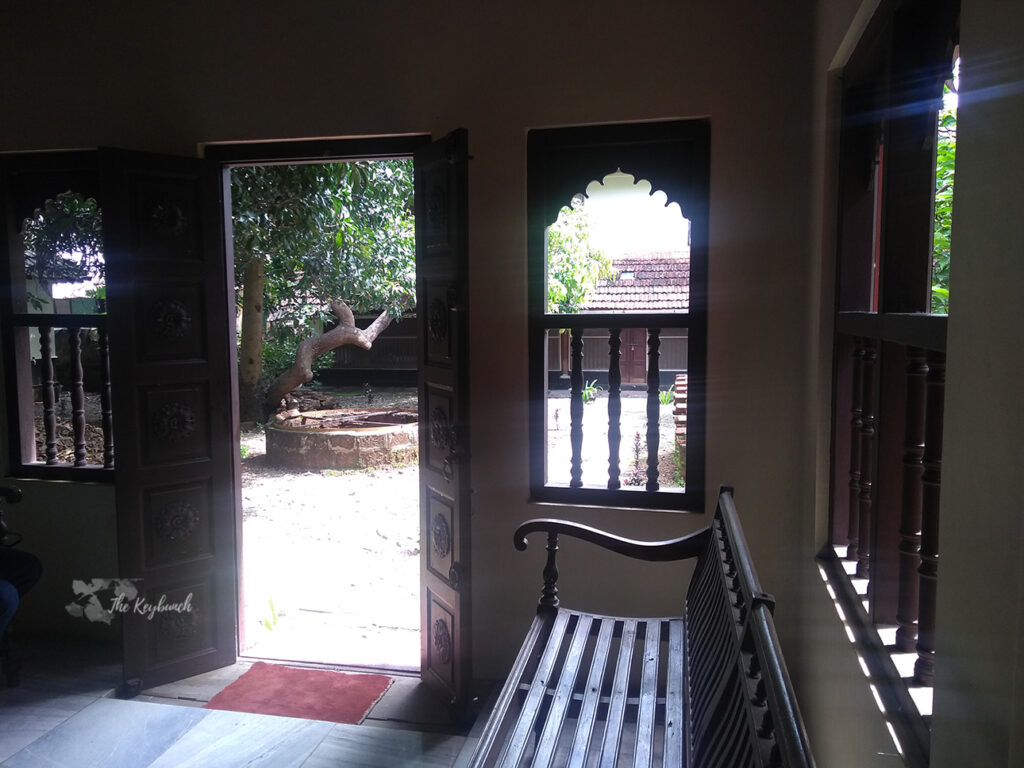
The vakil bench 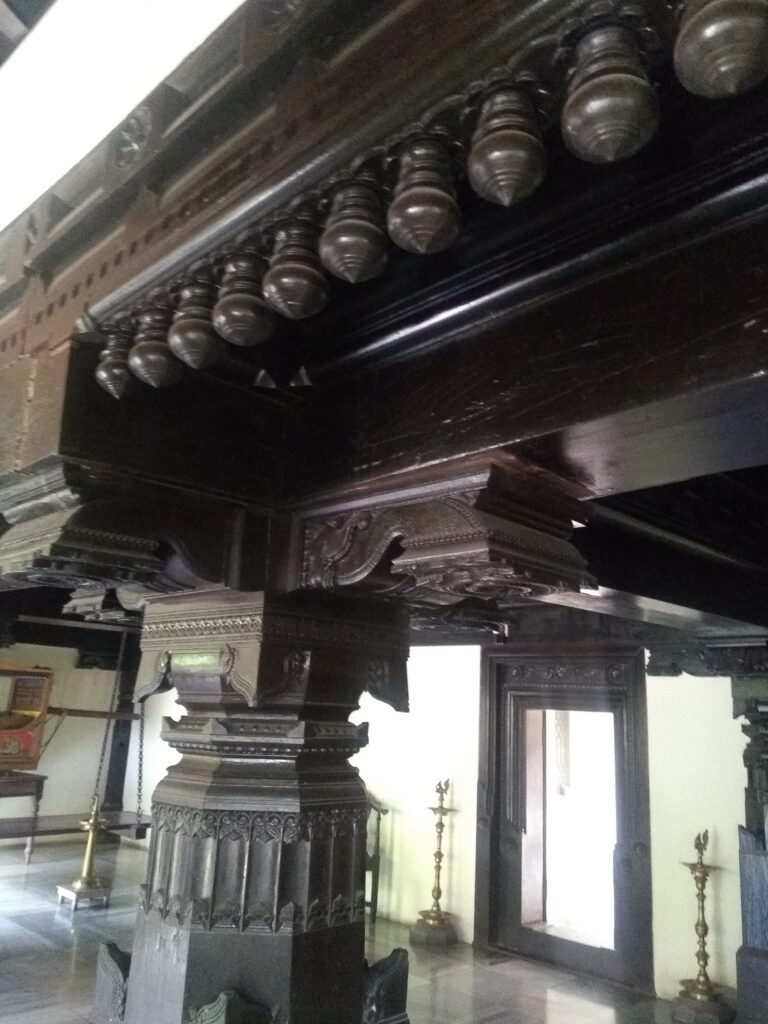
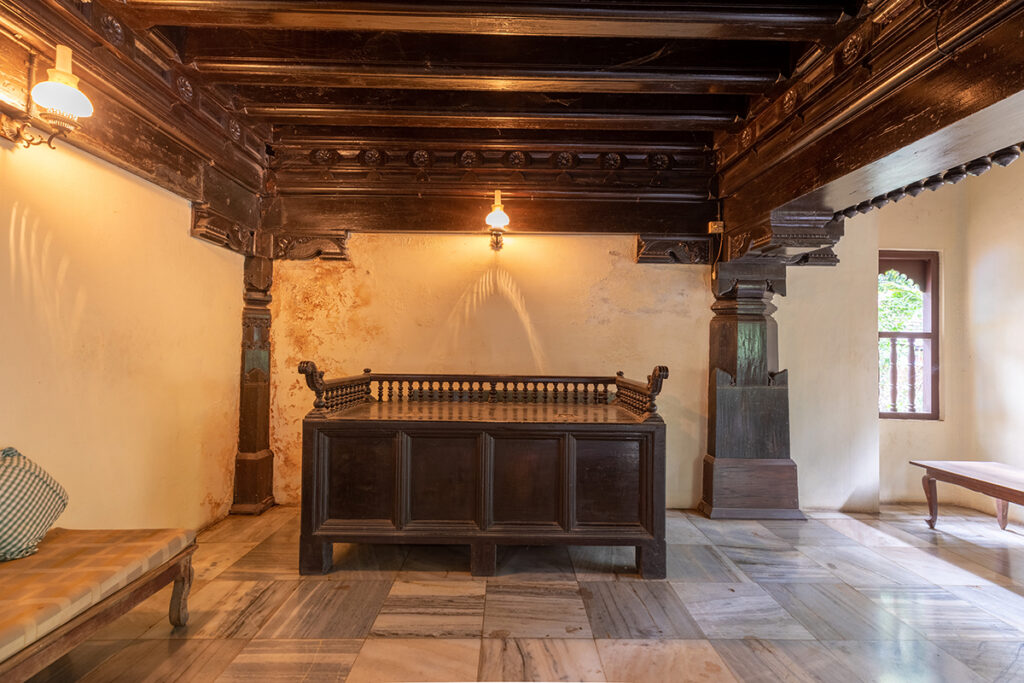

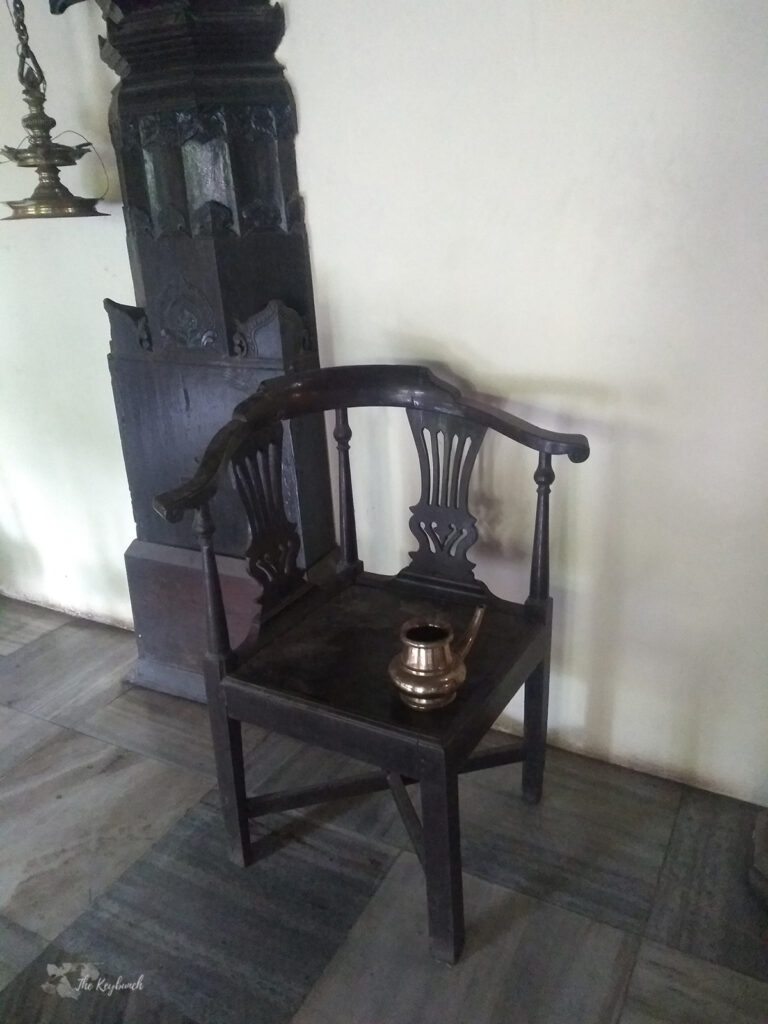
In the more regal homes, some of the woodwork have intricate carvings and ivory inlay work.
KodialGuthu – A Guthu Mane in Mangalore
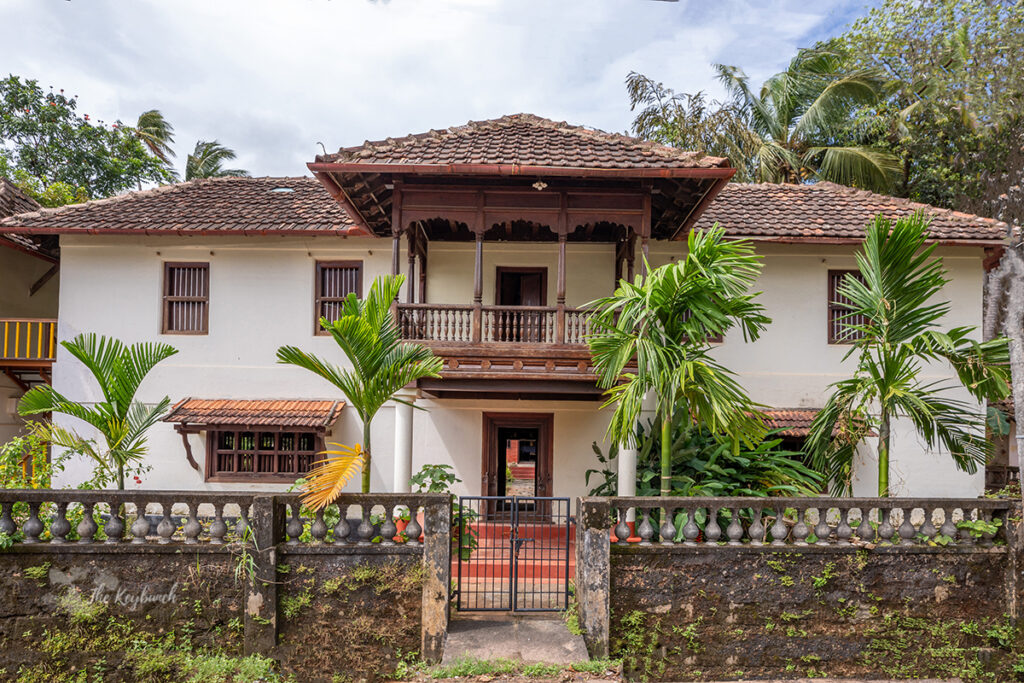
Kodialguthu House and the family have a history of over 600 years. The present structure of the house dates back to roughly around 250 years, and occupies a better part of a 2 acre plot.The daughters of Kaup Sarvotham Shetty and Kodial Guthu Kausalya Shedthi, Kodial Guthu Jyothi and Kodial Guthu Pratibha are the owners of the house. This is as per Aliyasantana system of matrilineal inheritance. While Jyoti Alva inhabits the main Guthu house and the new extension adjacent to it, her sister Pratibha Karanth has inherited the hebbagilu or the Main door, which like the royal homes of the past is actually a one storey building. The sisters have tried their best to keep the memories of their family legacy alive by maintaining their respective buildings beautifully. All the images in this blog post, including the ones shared earlier, are of the Kodialguthu house.
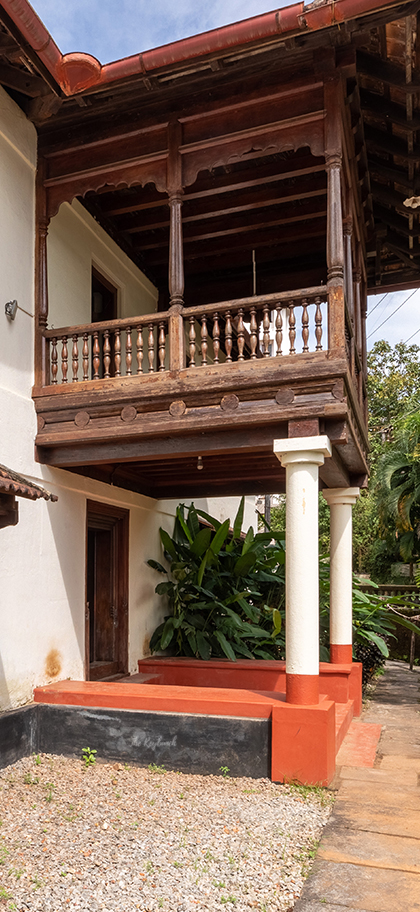
A Hobli Guthu House
The prestige and grandeur of this family can be ascertained from the fact that during the rule of the Vijayanagara Empire in the south, three Bunt Feudal houses were given the right to resolve civil and criminal disputes in the Mangalore area. The Kodial Guthu family head was the arbitrator of justice. The other bunt families that had this right were Jeppu Gudde Guthu and Badila Guthu. All three together are known as Mangalore Hobli Guthu houses. To maintain impartiality of the justice system marriages were forbidden between these three houses.
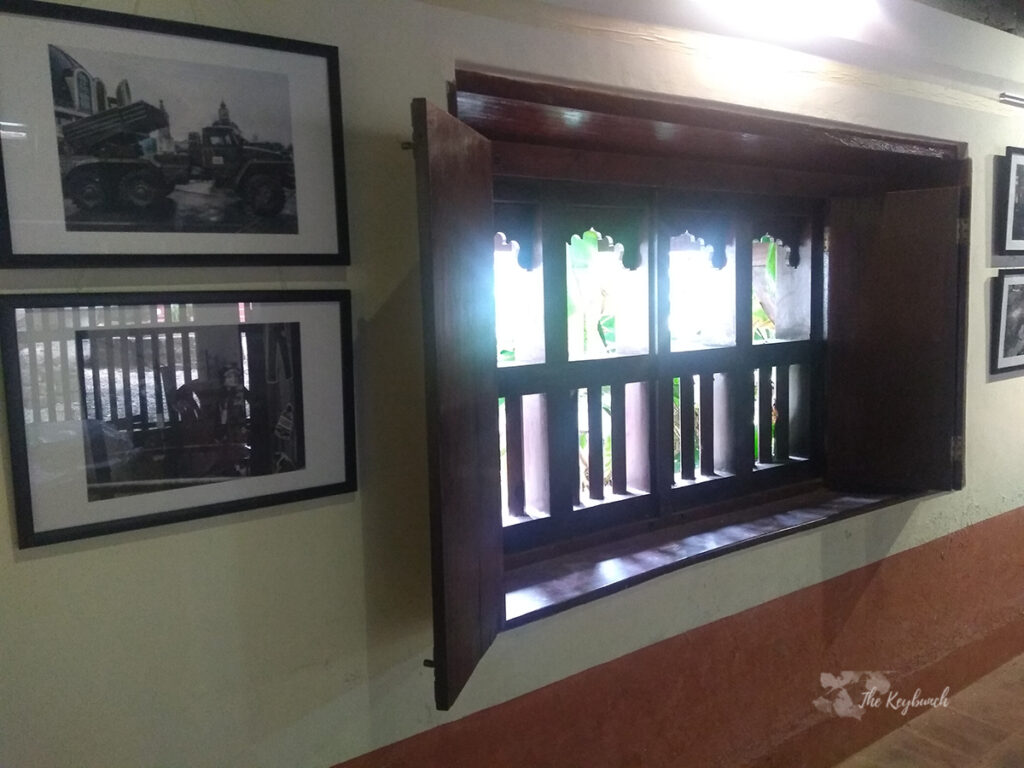
The family belongs to Gojjaranna lineage of Bunts. There is a possibility that Gojjaranna is a totemic symbol associated with Dogs. According to bunt folklore Gojjaranna families have deep affection for dogs and they go to great lengths to see that they are never harmed by anyone.
– THIS INFORMATION IS GLEANED FROM AN ARTICLE PUBLISHED BY INTACH, BASED ON INPUTS BY Belle Prajwal Shetty
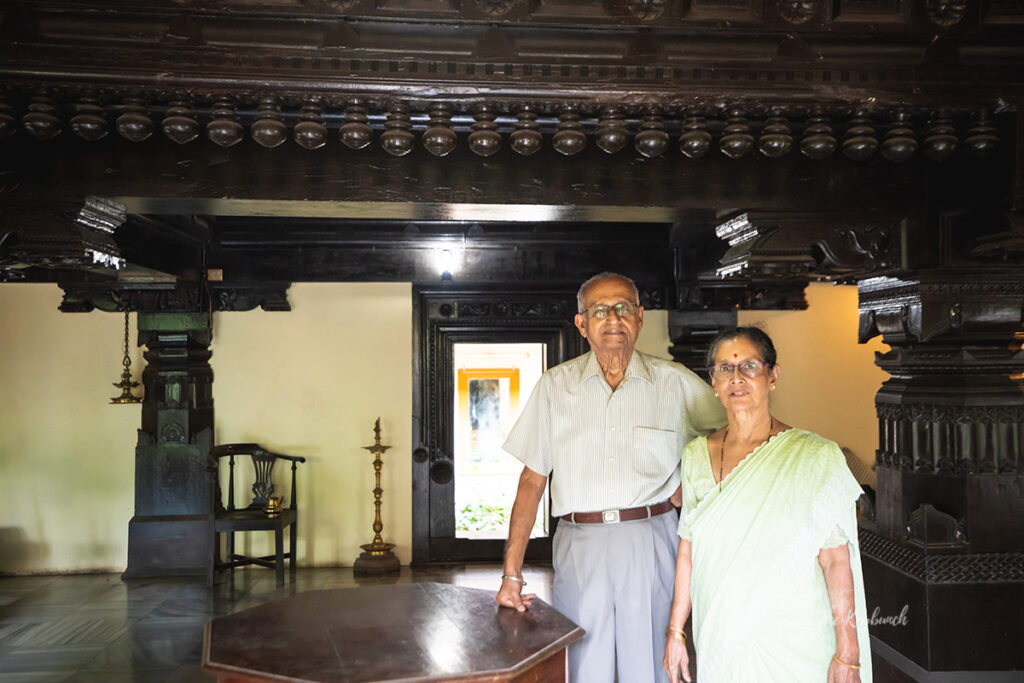
The image below will give you a better idea of the original structure, with the open jaal very typical of old Mangalore homes
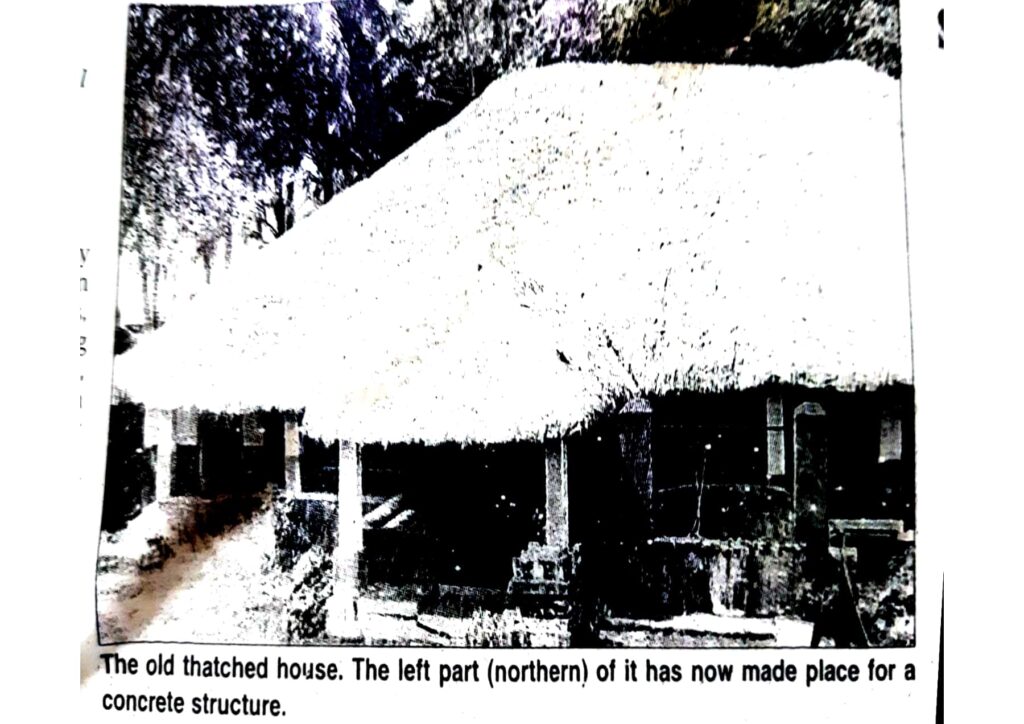
Only the chavadi of the old Guthu house is retained with everything untouched, except for a modern floor, as the old floor was difficult to maintain. The rest of the home is now converted into a modern residential structure.
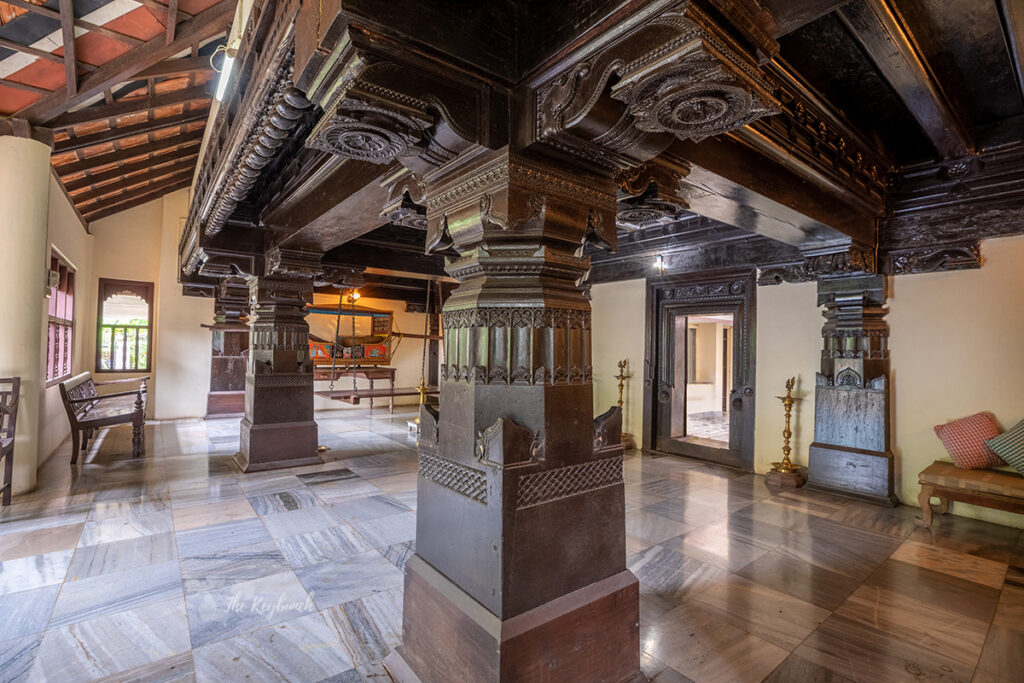
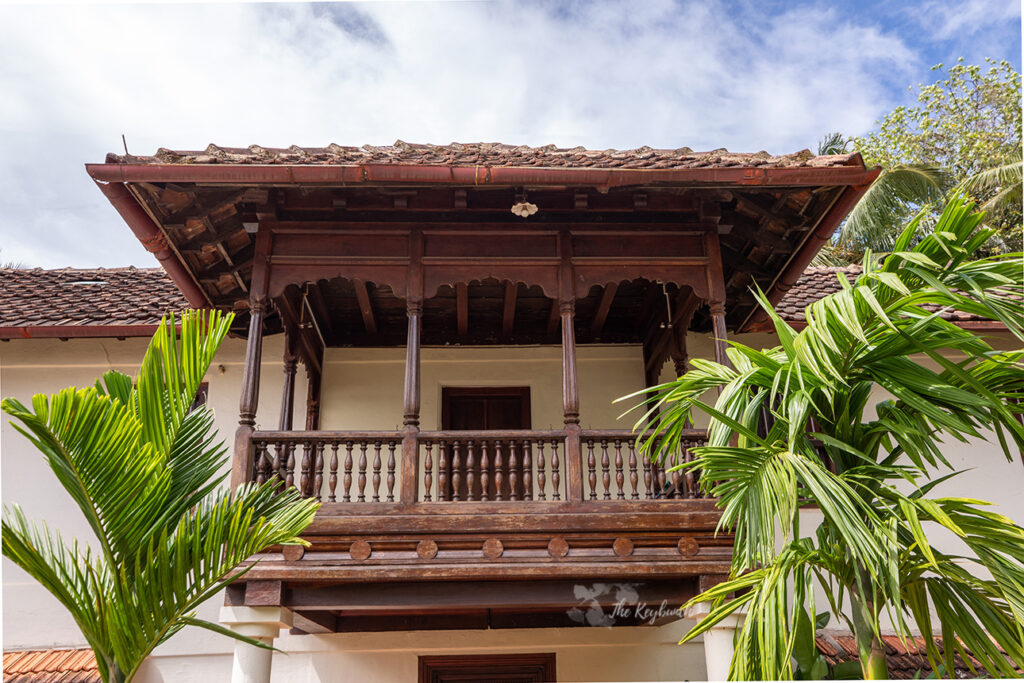
However, the entire hebbagilu still stands tall and regal, with it’s beautiful balcony, certainly the highlight of its stately facade. Here are some images of its beautiful exterior.
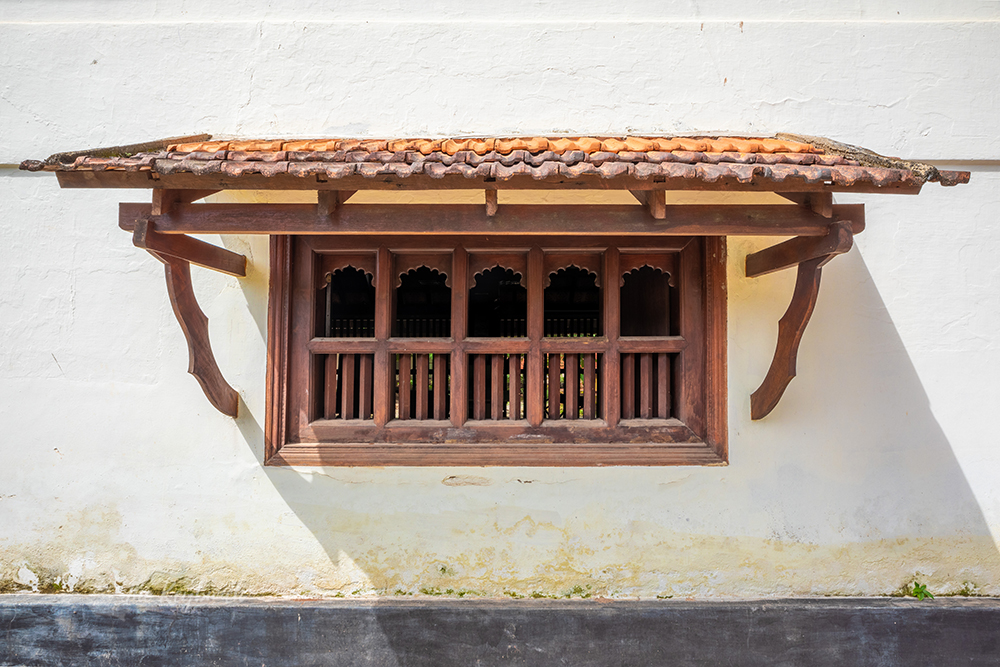
Kodialguthu House| Heritage home tour| The Keybunch| Jyoti Alva current owner
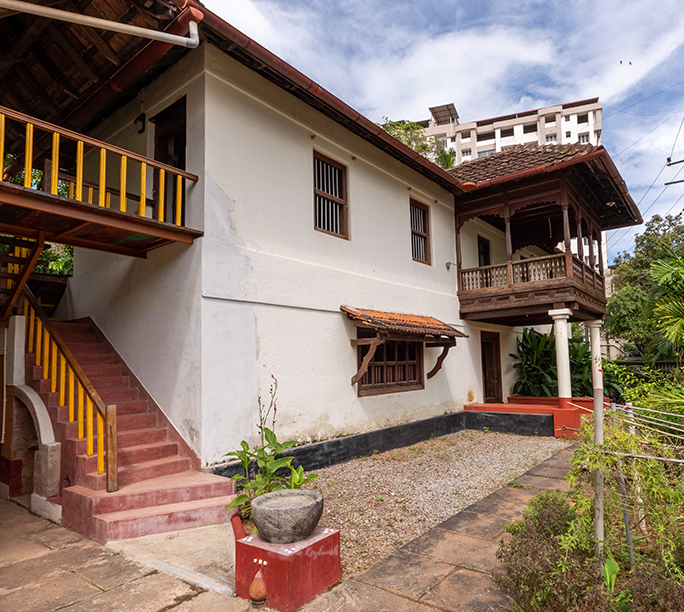
Inside the hebbagilu building
If only the front door to a home is so grand, I cannot even fathom the royalty that the old house once must have had! Inside the hebbagilu buidling is a long hall that is now in use as an art and media exhibition centre. A small part of the building is used by INTACH as their Mangalore Chapter office. This is the main room on the ground floor of the building.
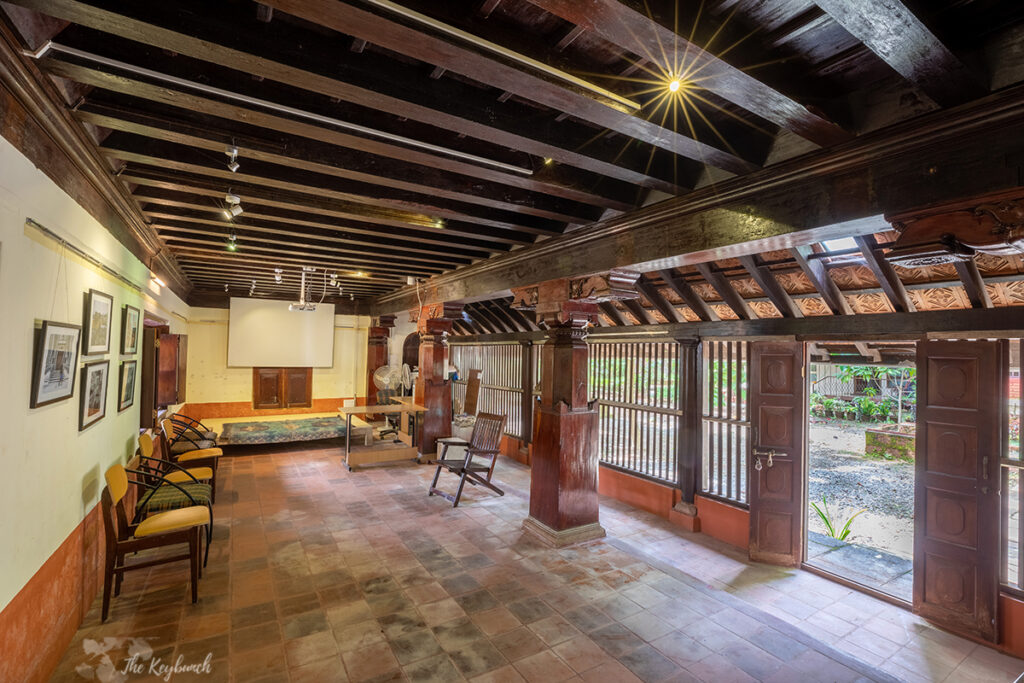
Upstairs, through a staircase attached to the outside of the main building, is another long hall, which is also part of the art gallery now. As you can see in the image below, original features like rafters as well as the little features such as the old light shades are still used.
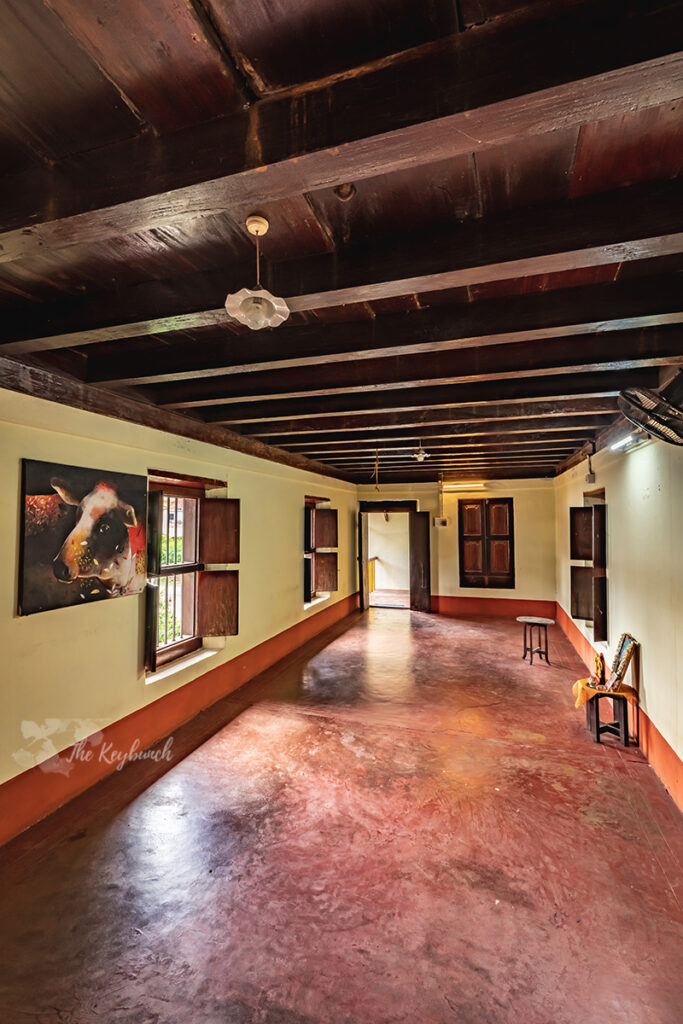
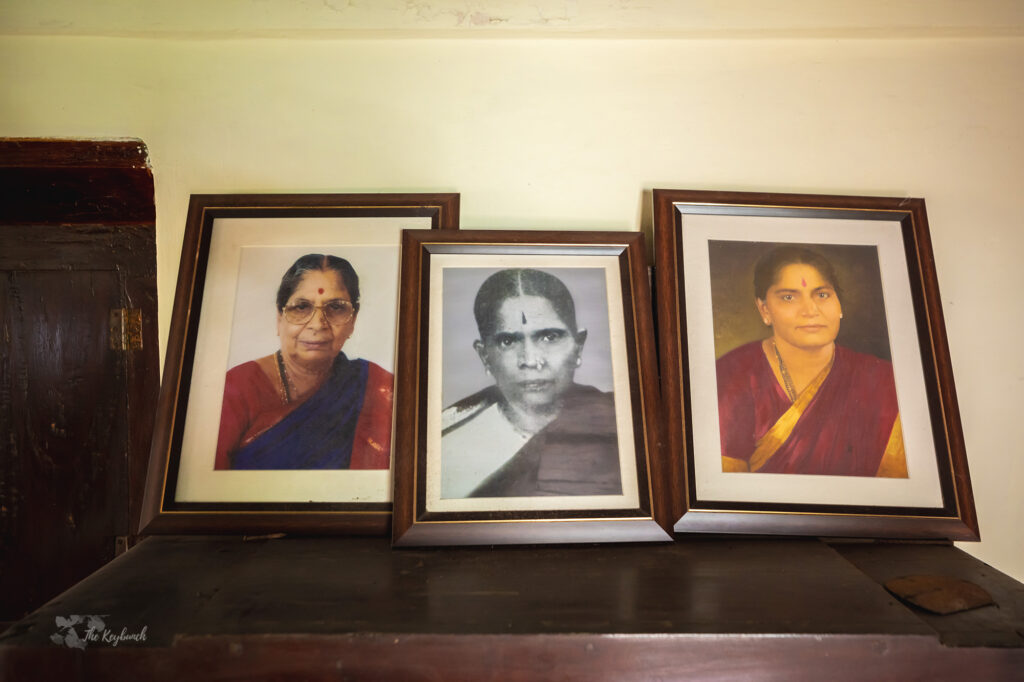
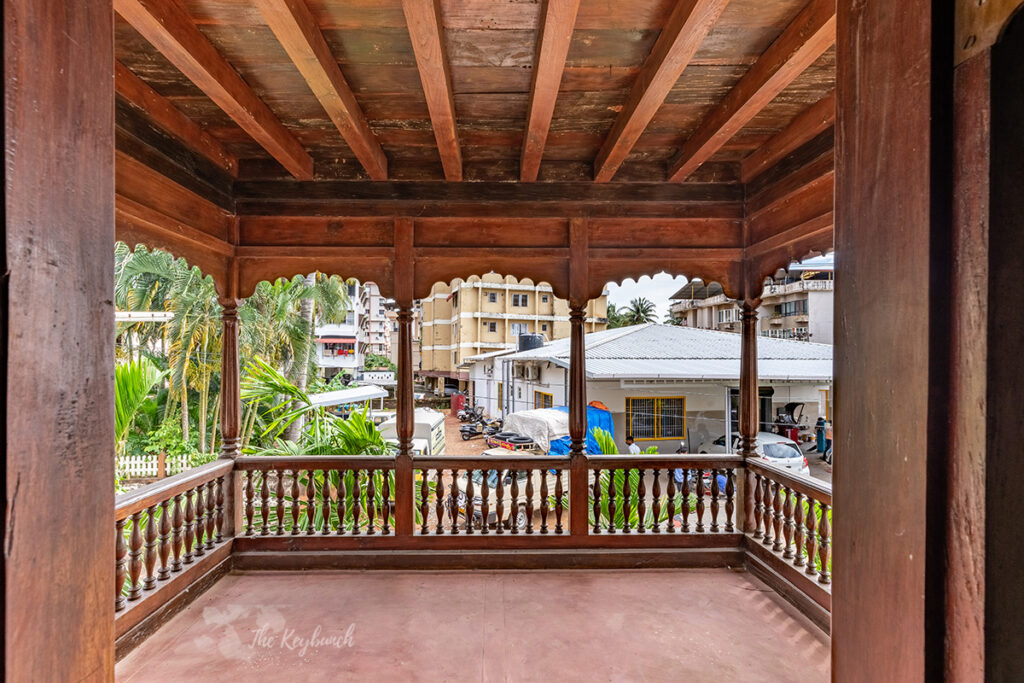
Out of the hebbagilu building, we walked across the courtyard to Jyoti Alva’s part of the house – actually, the original home with its chavadi.
Here is a glimpse of the view of the home you see today, as you approach the entrance of the house
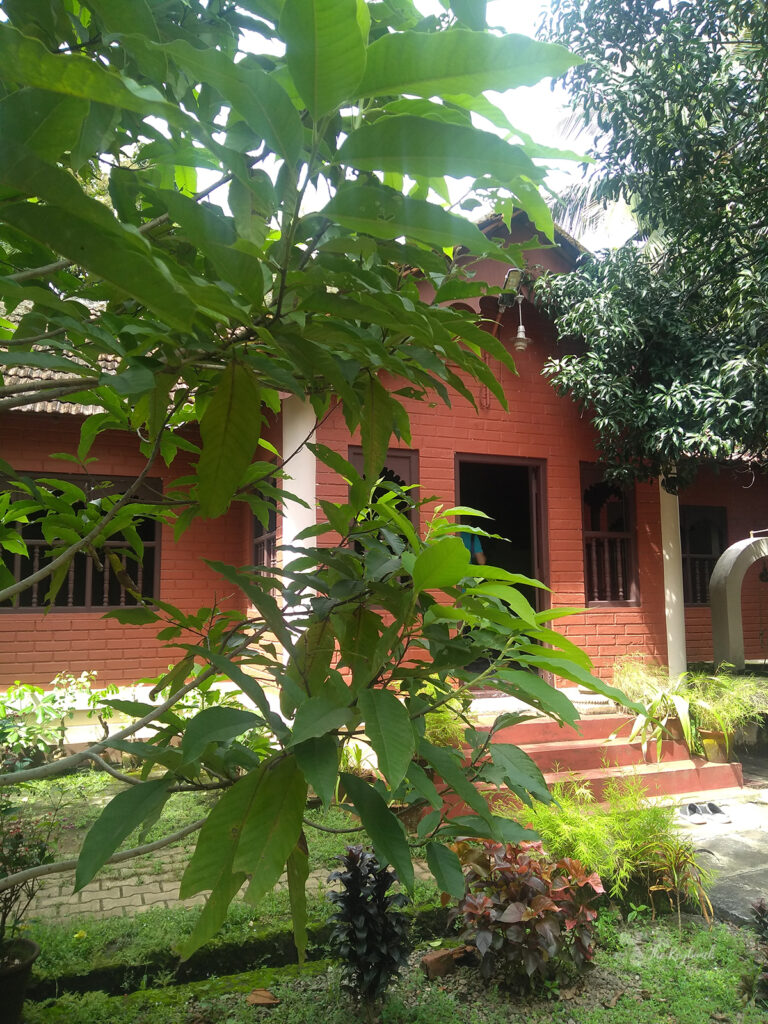
A closeup of the home, with the current owner at the doorway.
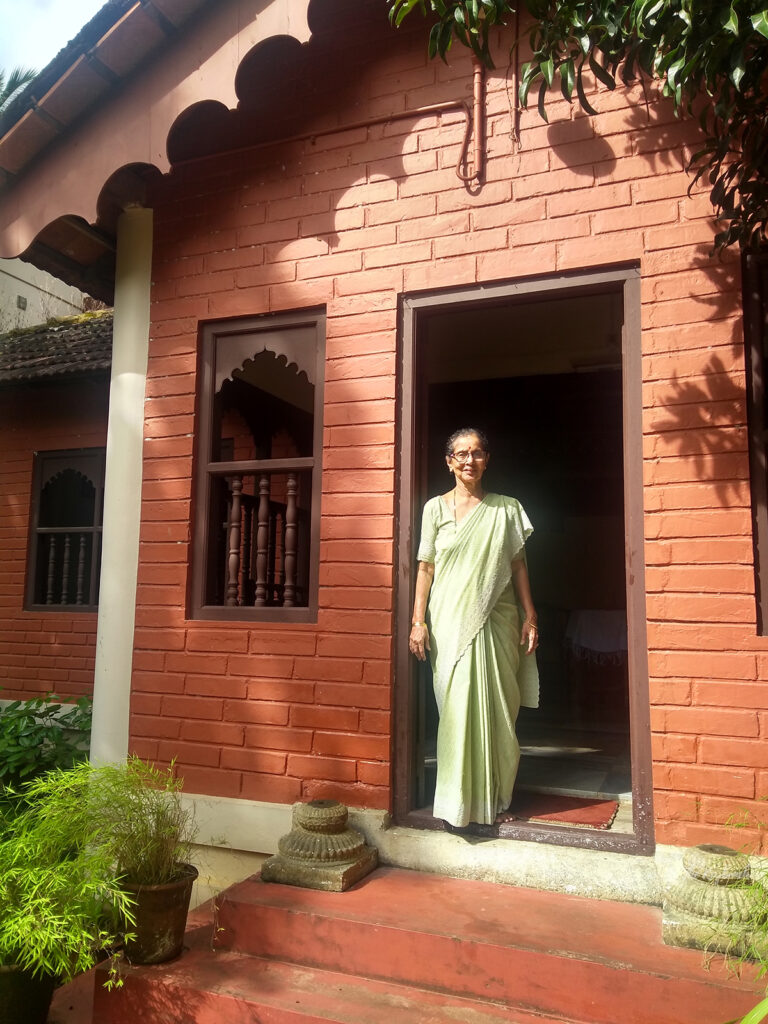
It used to orginally have an open verandah, and Jyoti has covered it, and replaced the thatched roof with tiled roof, as well as enclosed this space.

The chavadi is the most exquisite part of the home, where it seems like, in those old days, no expense was spared. Wooden rafters and pillars made of rose and teakwood with beautiful carvings of traditional motifs, welcome you as you step into this space.
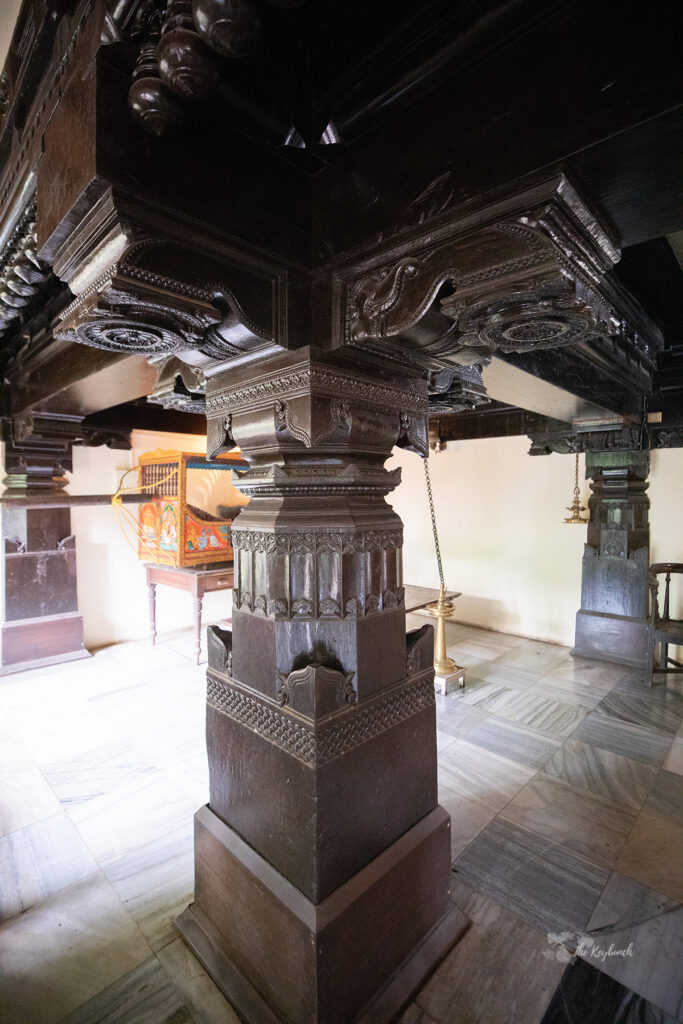
The sheer magnificience of this space just doesn’t come through in the pictures. However, when you stand here in person, it is truly stunning, with all that wood forming a canopy over you! This image below should give you a better idea!
Kodialguthu House| Heritage home tour| The Keybunch| chavadi
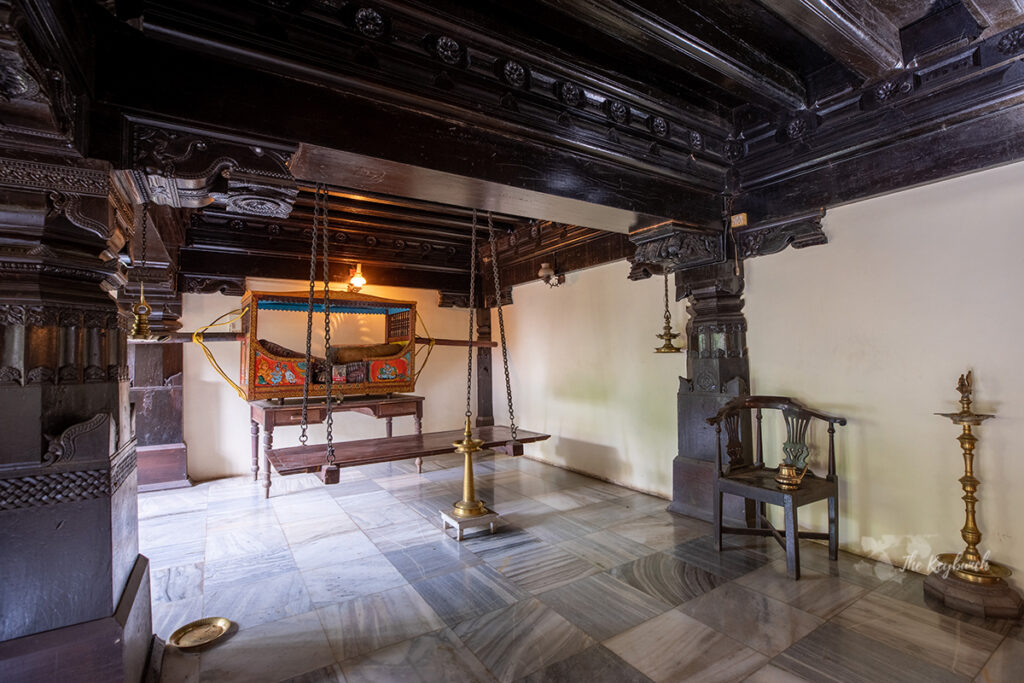
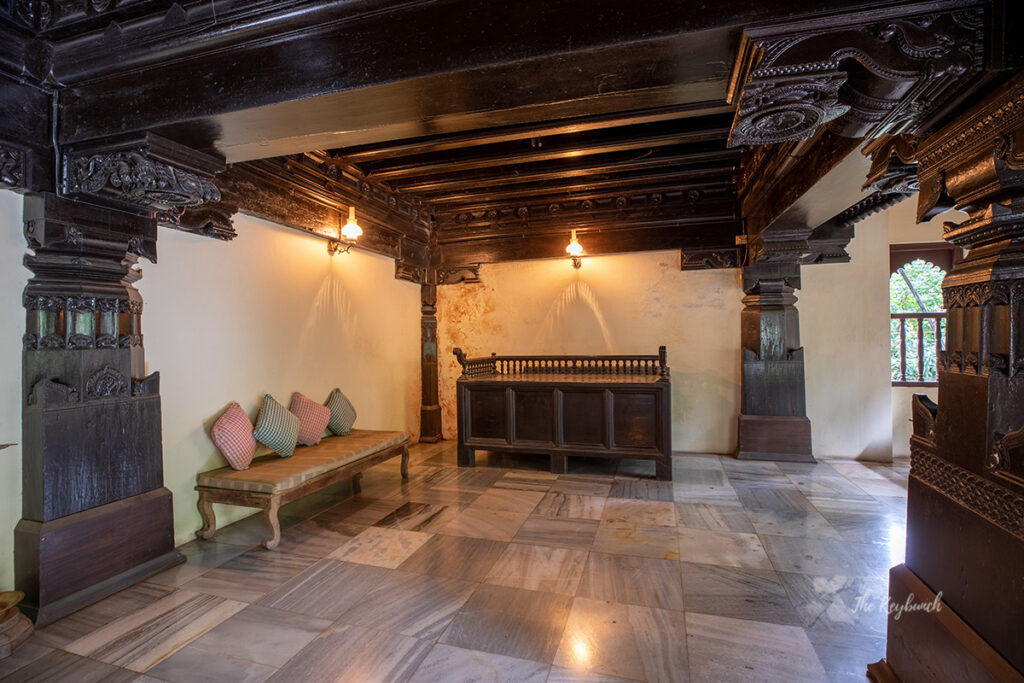
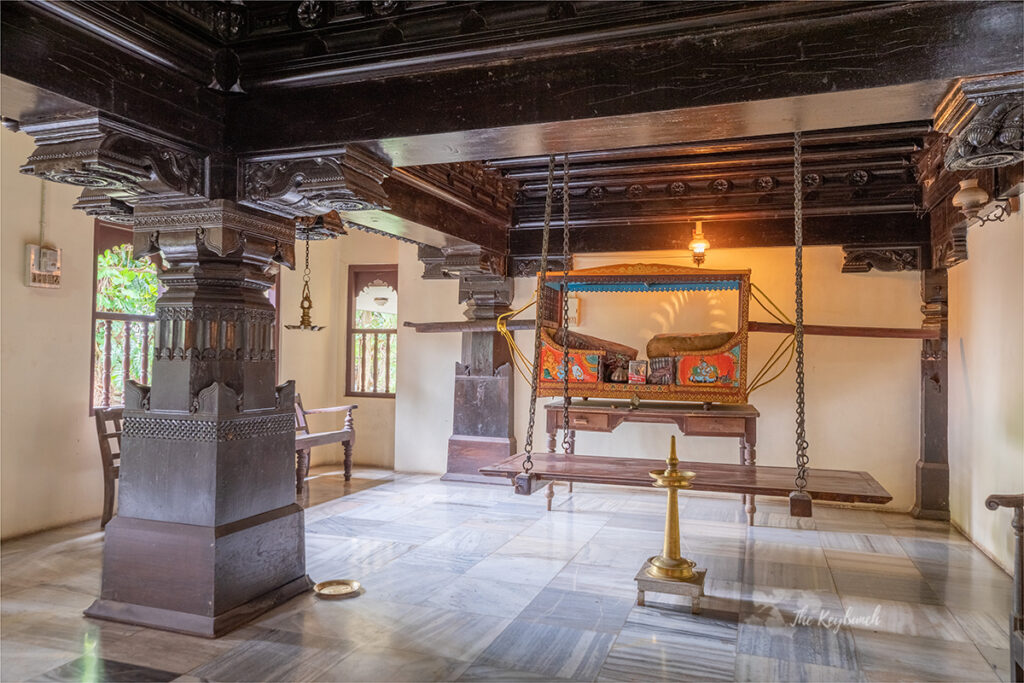
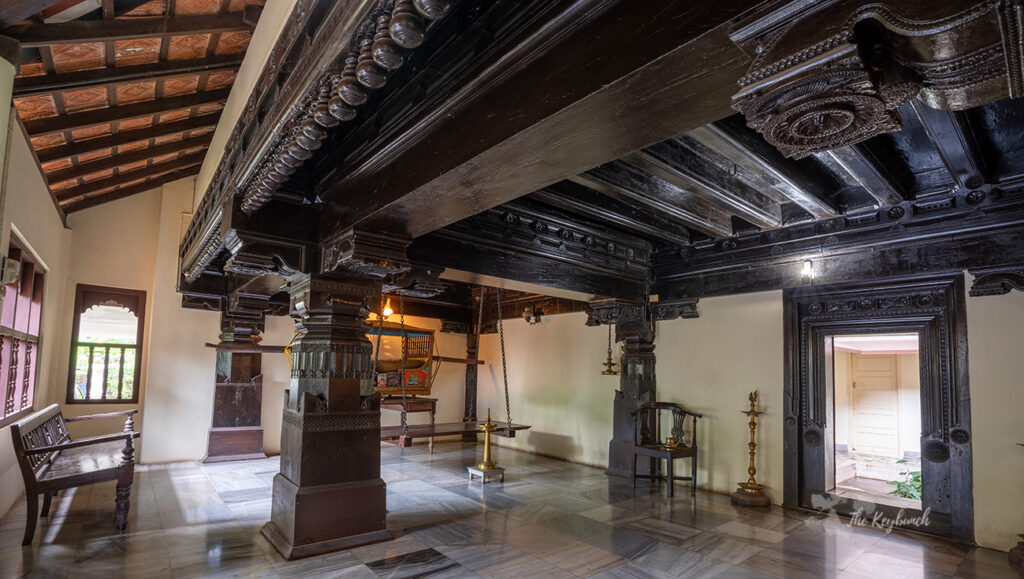
You can also catch a glimpse of the inner courtyard leading out of the chavadi. This area is where the old residential quarters used to be, now rebuilt in a modern style. On the left of the house, is a pond, where legend has it, that the water never runs dry. Jyoti Alva shared fond reminiscences of idyllic summer vacations spent in the pond with her cousins.
DID YOU KNOW?

The vakil bench is quintessiantly Mangalorean, and universal to all castes, religions and strata of society. The design is the same, whereever you see it. This makes it a much loved piece, and many old houses still have these benches prominently displayed in their verandahs!
Two points of view, where conservation efforts are concerened
Guthumane are the remnants of a life that once was. Few of them are maintained now, and many have been lost in family feuds for property, or just fallen to disrepair because of the costs of maintaining them Kodialguthu House in the heart of Mangalore is one of the few exceptions. Heritage afficionados criticize the Alvas for renovating the front portion, but given the high cost of maintenace, the increasing pollution and the damage that current environmental situations may cause to this priceless structure, I feel that it was done in the best interests. Old homes cost a lot of money to maintain, and it is admirable that the Alvas decided to preserve the beauty of the chavadi in the capacity they could. Even a purist like me is in agreement here. However, I really wish the old flooring was left intact, but again, that was a decision that the Alvas made, in view of their challenges in maintaining this home.
As we bid goodbye, I leave you with some of my favourite clicks of this gorgeous home!
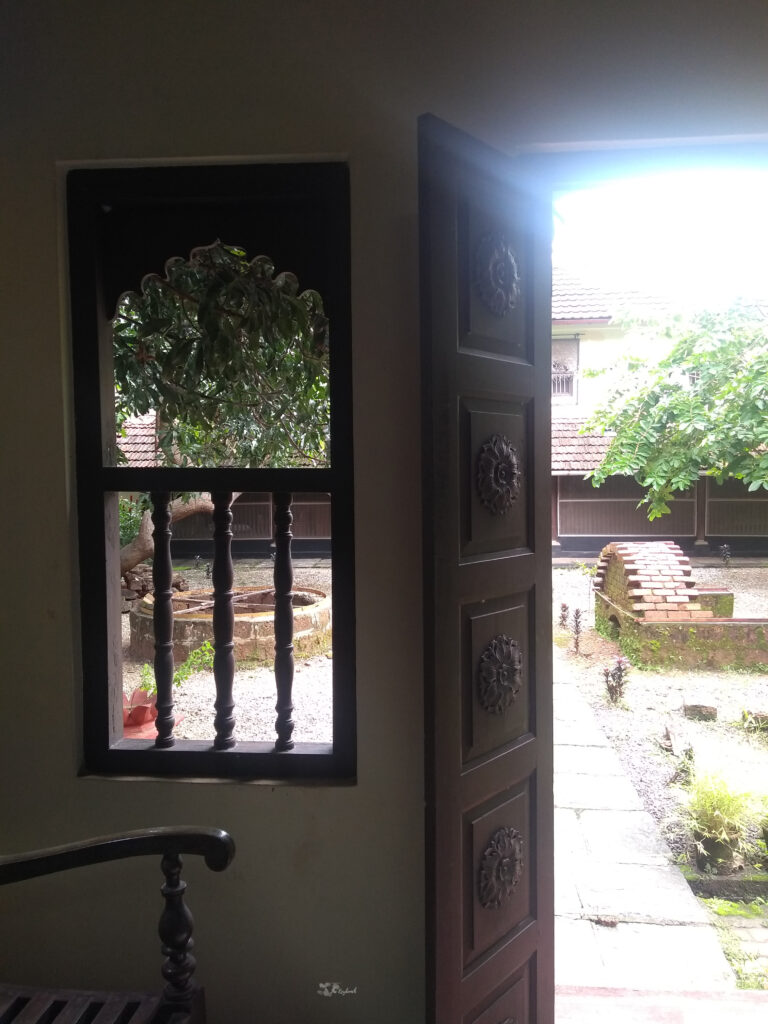
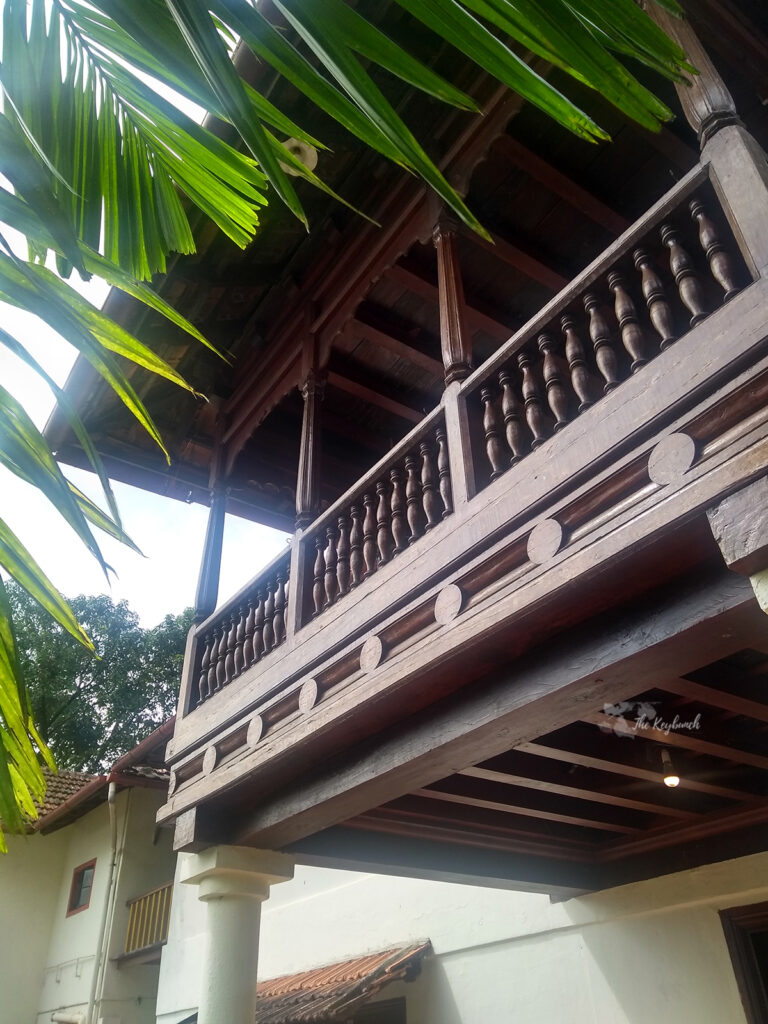
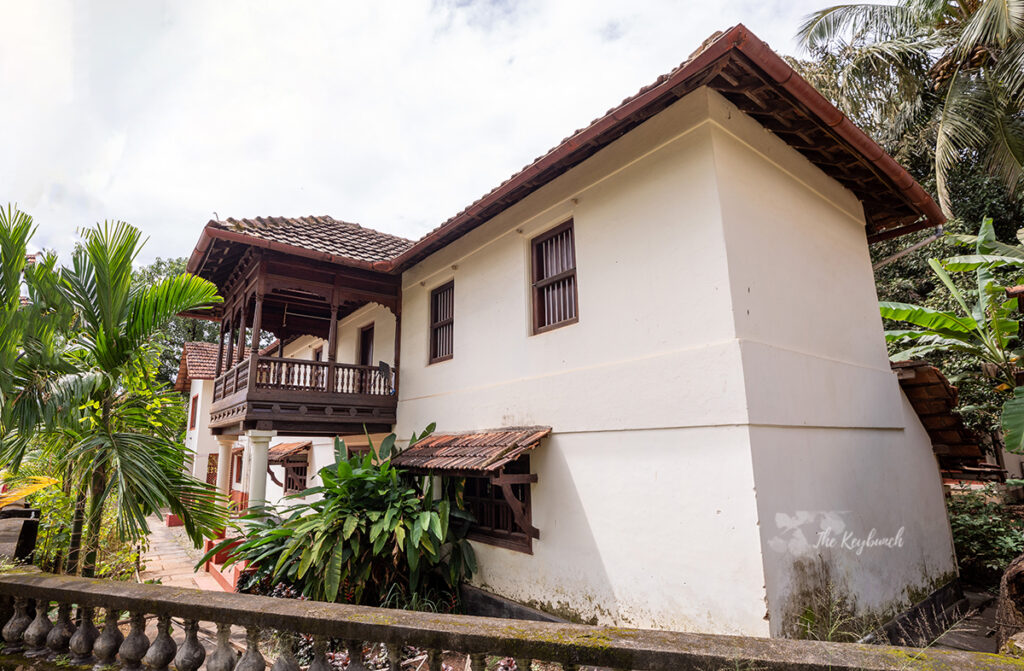
Heritage homes are just amazing, aren’t they? Did you like this home tour? My passion lies in documenting heritage homes, and if you wish to support my work, do write in or contact me.
This article was written based on the inputs recd from Mrs. Alva. Some of the information pertaining to the history of the family is gleaned from an article published by INTACH, with information provided by Belle Prajwal Shetty
The beautiful images here are pinned on Pinterest, so head to our board and pin away!
We are committed to bringing you quality home tours, blog posts and content. Do talk to me if you know of an interesting place that you think I should feature.
And, if you wan to hang around and browse around this blog, we would be happy for you to stay on. Here is a collection of our home tours to browse through.



